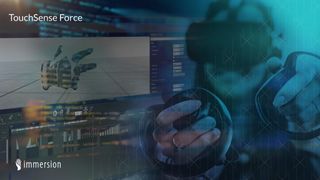For Haptics, Immersion Is The Company Behind The Companies

Haptics in gaming is one of those funny things where you usually notice them only when they’re done badly, like live concert audio. There are multiple companies that make haptics, and they work with all of the game designers, controller makers, and others that put haptics into games and devices. But behind those companies is Immersion (and others of its ilk) that make haptics possible.
What Immersion makes, as a rep told us at GDC, is not the rumble, but the thing that makes the rumble work. While visiting Immersion’s GDC suite, we got a demo of haptics on Oculus Touch controllers, a still-in-development gamepad, and the company’s new software tools.
Immersion’s primary goal is “consumerizing expensive technology” around haptics and then licensing its technology and software to others to implement. You’ve experienced Immersion’s technology if, for example, you’ve ever used a Sony or Microsoft gamepad.
Creating Haptics
The latest item on the company’s agenda is developing a software tool that makes cross-platform VR haptics development easier. (We wrote about this when it was first announced in late February.) Called the TouchSense Force for Game Developers, it’s software that lets you program haptics into games and experiences using multi-track timelines, and it’s designed for PC, console, and VR games--all from one interface. It’s available as a plug-in for Unreal and as an API for custom game engines.
If you’ve ever used audio multitracking software or video editing software, the visual interface will look familiar to you, in general. You can drop in effects, play with their length and “volume” (in this case how forceful they are, not how loud they are), add fade-ins and fade-outs, and otherwise fiddle with the waveforms.
We got a demo of the software at GDC:
The Rumbling In Our Hands
As part of the TouchSense suite, Immersion built in TouchSense for Peripherals. At GDC, they had a demo of the Oculus Touch controller and a yet-to-be-revealed gamepad that employed its haptic tech.
Stay on the Cutting Edge
Join the experts who read Tom's Hardware for the inside track on enthusiast PC tech news — and have for over 25 years. We'll send breaking news and in-depth reviews of CPUs, GPUs, AI, maker hardware and more straight to your inbox.
The Touch demo felt a bit more educational than anything else. We were placed in a shooting gallery with a table full of weapons, and we could pick them up and fire and reload. Immersion reps used this demo to point out how tricky it is to get haptics right.
For example, you can program down to a 1ms burst; if it’s off by even a hair, the experience can break down and stifle the immersion. Or take a high-RPM weapon like an uzi--you have to match the rounds as they leave the barrel, and you have to ensure that the kick isn’t too harsh or too soft, especially when compared to other weapons in a given game’s arsenal. You can’t have an uzi kick harder than a shotgun, for instance.
But the most compelling demo we experienced had to do with an unannounced game controller. It’s being made by a third party, and Immersion reps wouldn’t say who that was, and they wouldn’t let us take photos of it.
Suffice it to say, though, that if you use a gamepad for anything, you’re going to want this thing when it comes out.
They put me in an FPS game devoid of enemies and had me cycle through my vast loadout of weaponry--pistols, shotguns, automatic weapons, grenade launcher, zapper, you name it. Each weapon had distinct haptic characteristics from all the others. The aspects we discussed above--kick, rate, length, etc.--were all finely tuned.
When a weapon is empty, the feel changes, too. For example, we went to town with a Gatling gun, and as the rounds left the barrel, it was all we could do to hang onto the violently vibrating controller. Yet as soon as we ran out of ammo, the tension on the triggers went lax, and all we could feel was the gentle, rapid, click-click-click of the empty spinning gun. And when you reload, you can feel that, too.
Even oft-overlooked aspects like trigger feel have been addressed. For example, although some of the weapons in the demo had hair triggers, the shotgun requires you to squeeze much further and apply more force to fire.
We can hardly overstate how wide the range of haptic feedback was on the controller. The click of a pistol hammer on an empty revolver was minute, but the thunderous blast of a powerful machine gun kicks like a mule. When appropriate to the gameplay, the two triggers would even retract on their own--push/pull to go along with the force feedback.
The controller will be killer for regular 2D games and gamepad-based VR titles alike. There’s no word on when it will be released nor how much it might cost (probably a lot), but we know that it’s coming “later this year” and will be bundled with a game.
If you want early access to Immersion’s TouchSense suite, contact the company from here.
Most Popular



